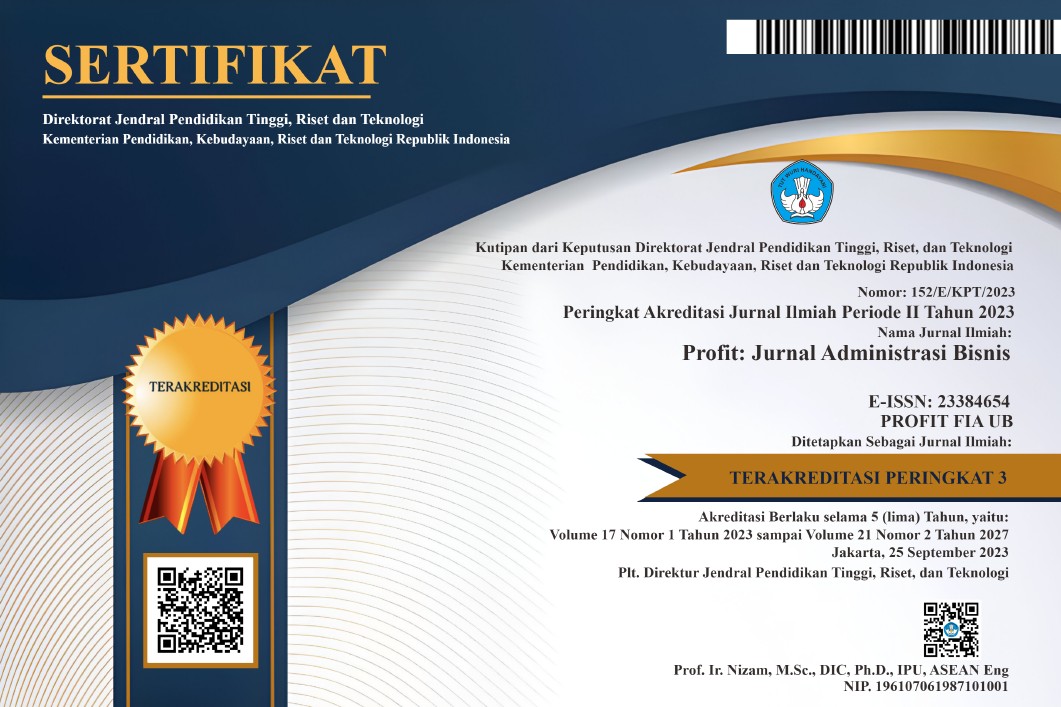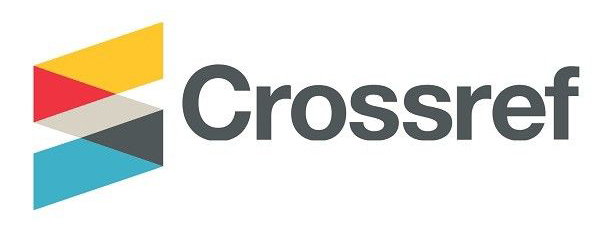THE EFFECT OF SOCIAL COMMERCE CONSTRUCT AND BRAND IMAGE ON CONSUMER TRUST AND PURCHASE INTENTION
DOI:
https://doi.org/10.21776/ub.profit.2016.010.01.1Keywords:
social media, instagram, social commerce, GSCAAbstract
Social commerce is a new development of e-commerce by using social media platform to interact on the internet. Current studies only examine the model on its own basis by using direct effect only. This research examines both of the model together to reveal which factor that give the greater effects against consumer trust and purchasing intention both direct effect, indirect effects and total effects. Drawing a literature from marketing and information systems (IS) the author proposes a model to understand the relationship between social commerce construct and the brand image against the purchasing intention in Instagram. The study utilized Generalized Structured Component Analysis (GSCA) methodology to test the model. The research object was the @fujifilm_id instagram followers as many as 99 respondents. Results shows that social commerce construct are likely to give greater effect against the purchase intention rather than by the brand image whether in direct, indirect and total effect. Yet, the brand image is a crucial part of a brand which is needed to be maintained against customer perspective. Implication, limitation, discussion and future research direction are also discussed.
Â
Â
References
Aghekyan, Marine. 2009. The role of product brand image and online store image onPerceived risks and online purchase intentions. Alabama: Auburn Universities
Aghekyan, Fosrthye, & Kwon. 2012. The role of product brand image and online store image on perceived risksand online purchase intentions for apparel. Journal of Retailing and Consumer Services 19 (2012) 325–331
Arista, Elisabeth D. 2011. Analisispengaruhiklan, brand trust dan brandimage terhadapminatbelikonsumentelkom speedy di kotasemarang. Diponegoro University
Bagozzi, R. P., &Dholakia, U. M. 2002. Intentional social action in virtual communities. Journal of Interactive Marketing, 16(2), 2–21 (John Wiley & Sons).
Chen, J., Xu, H., &Whinston, A. B. 2011. Moderated online communities and qualityof user-generated content. Journal of Management Information Systems, 28(2),237–268.
Chin, W. W. 1998. Issues and opinion on structural equation modeling (Editorial). MIS Quarterly, 1. Available from http://search.ebscohost.com/login.aspx?direct=true&db=buh&AN=345479&site=ehost-live
Do-Hyung, P., Jumin, L., &Ingoo, H. 2007. The effect of on-line consumer reviews on consumer purchasing intention: The moderating role ofinvolvement. International Journal of Electronic Commerce, 11(4), 125–148.http://dx.doi.org/10.2753/jec1086-4415110405
Emarketer. 2014. APAC Ranks No. 2 Worldwide for Social Network Ad Spend Share. Emarketer.com, retrieved 16/3/2015 from [http://www.emarketer.com/Article/APAC-Ranks-No-2-Worldwide-Social-Network-Ad-Spend-Share/1011221]
Emarketer. 2014. Digital Grabs a Sliver of Ad Spend in India, Indonesia. Emarketer.com retrieved on 16/3/2015 from [http://www.emarketer.com/Article/Digital-Grabs-Sliver-of-Ad-Spend-India-Indonesia/1011747#sthash.kRjZRxmq.dpuf]
Ferrinadewi, Erna. 2008, “MerekdanPsikologiKonsumenImplikasipadaStrategiPemasaranâ€, edisipertama, GrahaIlmu, Yogyakarta.
Gefen, D., Rigdon, E. E., & Straub, D. 2011. An update and extension to SEM guidelines for administrative and social science research. MIS Quarterly, 35(2), iii-A7
Gefen, D., & Straub, D. W. (2004). Consumer trust in B2 C e-commerce and the importance of social presence: Experiments in e-products and e-services. Omega,32(6), 407–424. http://dx.doi.org/10.1016/j.omega.2004.01.006
Hajli, N. (2014). The role of social support on relationship quality and social commerce. Technological Forecasting and Social Change, 87, 17–27.
Hajli, N., & Lin, X. 2014. Exploring the security of information sharing on socialnetworking sites: The role of perceived control of information. Journal of BusinessEthics, 1–13. http://dx.doi.org/10.1007/s10551-014-2346-x
Hajli. 2015. Social commerce constructs and consumer’s intention to buy. International Journal of Information Management 35: 183–191
Hargadon, A. B., &Bechky, B. A. 2006. When collections of creative become creative collectives: A field study of problem solving at work. Organization Science, 17(4), 484–500.
Hubanic, Arijana&Hubanic, Vedrana. 2008.Brand Identity and Brand Image. University of Gothenburg fromhttps://gupea.ub.gu.se/bitstream/2077/19462/1/gupea_2077_19462_1.pdf accessed on 08/13/2015
Keller, K. L. (1993). Conceptualizing, measuring, and managing customer-based brandequity. Journal of Marketing, 57(1), 1-22.
Kim, Sanghyun& Park, Hyunsun. 2013. Effects of various characteristics of social commerce (sCommerce) on consumers’ trust and trust performance. International Journal of Information Management 33: 318– 332
Kotler et al., 1999. Principles of marketing. New York: Prentice Hall
Kotler, Philip dan Keller, Kevin Lane. 2005. ManajemenPemasaran, Indeks, Jakarta.
Lau, G.T., and Lee, S.H. 2000. Consumer Trust in Brand and the Link to Brand Loyalty. Journal of Market Focused Management. 4, pp. 341-370
Liang, T.-P., & Turban, E. 2011. Introduction to the special issue social commerce:A research framework for social commerce. International Journal of ElectronicCommerce, 16(2), 5–14.
Ming-Hsien, Y., Chandlrees, N., Binshan, L., & Hung-Yi, C. 2009. The effect ofperceived ethical performance of shopping websites on consumer trust. Journalof Computer Information Systems, 50(1), 15–24.
Mutz, D. C. 2005. Social trust and e-commerce: Experimental evidence for the effects of social trust on individuals’ economic behavior. Public Opinion Quarterly, 69(3), 393–416. http://dx.doi.org/10.1093/poq/nfi029
Prabowo, Riefky. 2014. Analisispengaruhiklan, brand trust dan brand imageterhadapminatbelikonsumenmastinekstrakkulitmanggis di kota Malang. University of Brawijayamalang
Ridings, C. M., &Gefen, D. 2004. Virtual community attraction: Why people hangout online. Journal of Computer-Mediated Communication, 10(1)
Rothberg, D. 2005. "Yahoo Unleashes a User-Plugged Shoposphere," in: eWeek.com
Rotter JB. 1971. Generalized expectancies for interpersonal trust. American Psychologist 26:443–50.
Rubel, S. 2005. "2006 Trends to Watch Part Ii: Social Commerce," in: Micro Persuasion.
Semuel, Hatane&Lianto, Adi S. 2014. Analisis ewom, brand image, brand trust danminatbeliproduk smartphone di Surabaya. Jurnalmanajemenpemasaran, vol. 8, no. 2, October 2014
Stephen, A.T., and Toubia, O. 2010. "Deriving Value from Social Commerce Networks," Journal of Marketing Research (47:2), April, 2010, pp. 215-228.
M. Tenenhaus, Component-based Structural Equation Modelling, [Online], http://www.hec.fr/heccontent/download/4797/115324/version/2/file/CR887TENENHAUS.pdf, 2008.
Wijaya, Bambang. 2013. Dimensions of Brand Image: A Conceptual Reviewfrom the Perspective of Brand Communication. European Journal of Business and Management, Vol.5, No.31, 2013
Yubo, C., &Jinhong, X. 2005). Third-party product review and firm marketing strategy. Marketing Science, 24(2), 218–240. http://dx.doi.org/10.1287/mksc.1040.0089
Zang, Michael. 2015. Graph: How the Mirrorless Camera Industry in Japan Changed in 2014. Petapixel.com retrieved 18/3/2015 from [http://petapixel.com/2015/01/31/graph-mirrorless-camera-industry-japan-changed-2014/]
Downloads
Published
Issue
Section
License
The copyright of the received article shall be assigned to the journal as the publisher of the journal. The intended copyright includes the right to publish the article in various forms (including reprints). The journal maintains the publishing rights to the published articles.

This work is licensed under a
Creative Commons Attribution-NonCommercial 4.0 International License

















